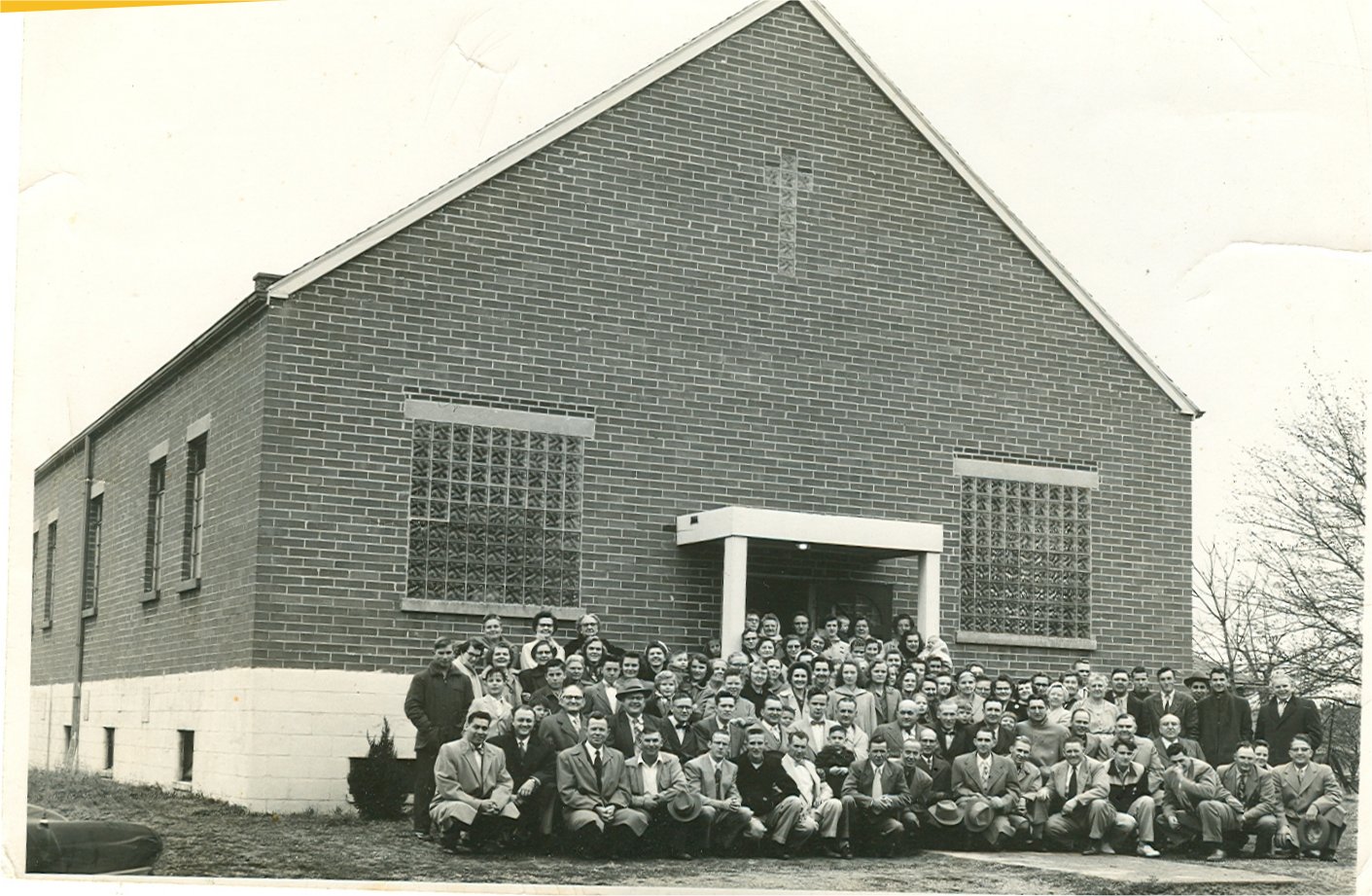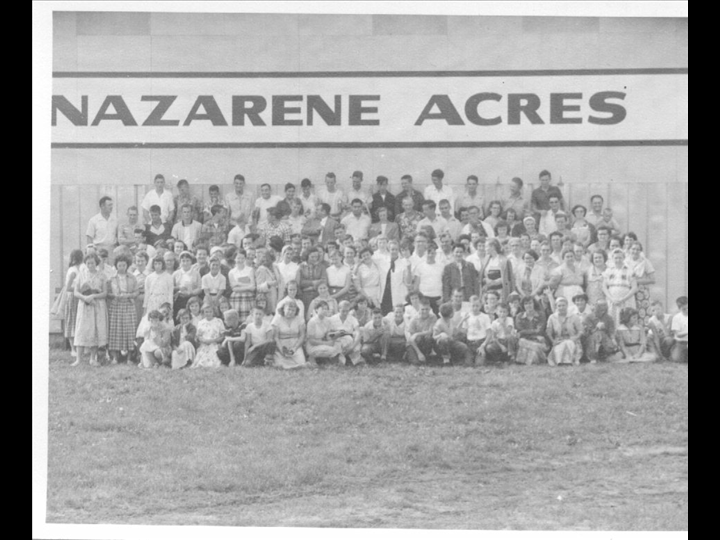|
The History of the Bethel Ministerial Association
|
Chapter 7 |
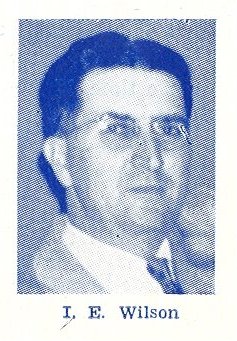
|

Brother Wilson at Camp |
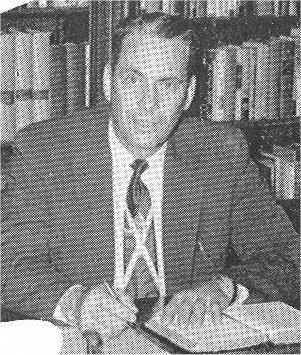
Brother Etnier at his desk |
|
Without doubt, the unbridled passion now growing in the churches of the E.M.C. could be directly attributed to revival passion among them. New Secretary, Brother Etnier reported in the first minutes of 1950 that “there is a trend in our midst to seek the Lord and yield to Him at all times. The meeting in Rockport was just closed. It was a profitable one. We decided we needed to go one step farther in spiritual things.” Anyone who has ever been closely associated with this group can testify to the hunger for things of the Lord as always evident. Its pastors believed in the filling of the Holy Spirit with all the blessings that it brought. Anyone could witness this group of people always wanting more and more of the Lord in their lives, ministries and outreach. At the February 1951 meeting in Logansport, it is recorded that there was much discussion about the Young People’s camp meeting for that year. This is the first mention of the word “camp” in any of the minutes, but not the first mention of dedicated meetings of the group’s youth. To this point, a dedicated time just for youth meetings had been scheduled first in churches and then during specific conferences in member churches. The early 1950s saw the Council now moving in the direction of regular camp programs....a concept that had become very popular in the late 40s and early 50s. Although details about the camp program were not initially mentioned, early meetings by the association for Youth Camps occurred in Bethany, Ill, a camp ground southeast of Decatur. Fees for each youth had started out at $1 per youth, then $2 when Youth Conferences were held in local churches. Now, in 1951, with dedicated programs at camp grounds, the price per youth had elevated to $7.60. It was always the responsibility of the local pastor to collect money for each of their church’s participants and qualify them to attend. It appears the youngest age was 13 for each youth and anyone younger than that attending was expected to be supervised by their parent. For the 1951 Camp, “Clara Wright was appointed to take charge of insurance. Brother Etnier was in charge of groceries and advertising and Brother Schwambach was asked to produce the first schedule. He had different ones give suggestions.” The ministers meeting February 1951 also considered another name change and an 18 year old Donnie Matthews asked to be ordained. For the first recorded time in the group’s history, “he was notified that it was necessary to be licensed a year before ordination.” It is significant that such a young man, who was growing up under Brother Varnell’s leadership, would be so driven that he would ask for ordination at such a young age. It was also significant that the association did not shy away from encouraging young men to enter the ministry and find ways to serve the Lord with their lives. This probably prompted the last item in the minutes where “Brother Varnell was asked to fix up a questionaire for ordination”, the first of many documents that the association would use to ordain its pastors, missionaries, preachers and evangelists over the years. May 1951, at the Evansville conference, finds the first introduction in the records of the name Rev Merwyn Masters. This might not have been the first time Brother Masters was involved with the association, but it is his first mention...it would not be his last. His involvement over the years would be very instrumental to the association. He led in prayer at this meeting. The first order of business was discussing the suggestion that the group once again change their name. The minutes record that, “many expressed themselves”, an action that we have never had any problem doing. “Finally, it was decided to present for vote the name, The Ministerial Council of the Bethel Assemblies.” Brother Scott made the motion, Brother Schwambach seconded it and the motion passed by majority vote. The “council” had again changed their name, this time, for the first time including the name “Bethel” in its title. Several of the member churches had Bethel in their names...Bethel Temple, Bethel Tabernacle...Brother Varnell gave direct inspiration to the name of Bethel in our association. The name was voted on and “Bethel” has been with us ever since. |
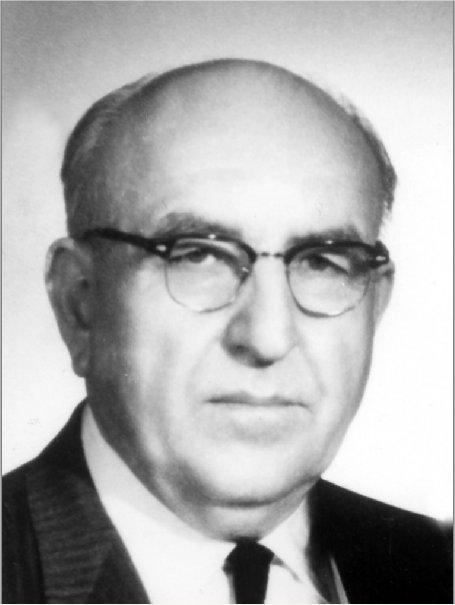
Rev A.F. “Doc” Varnell |
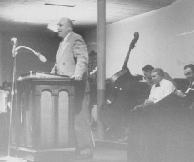
Early 1950s service at new Bethel Temple, 7th and Main St, Evansville |
|
Maybe most significant for the day though, Brother Varnell announced that because of ill health, he too would be submitting his resignation as chairman. Everyone expressed their concerns and thankfulness for Brother Varnell’s fifteen years of leadership. They reluctantly accepted his resignation and voted for several changes of leadership positions within the organization. At the strong recommendations of Brother Varnell, the newly named Ministerial Council of the Bethel Assemblies elected Brother Don Etnier as its new chairman and Brother Badger as the new Secretary-Treasurer of both the Council and the Missionary Board. The new decade would see a new name and new leadership for the future. Brother and Sister Varnell had recently passed leadership of Bethel Temple, which had moved the church to 7th and Main St in Evansville, to Brother Schwambach. Fairly soon after this, they would move to California for Brother Varnell’s health. But even then, Brother Varnell continued to be a presence in leadership among the Bethel brethren. As our pastors grew older, almost all of them were very successful in bringing up younger, capable leadership to take their places. Sometimes, new pastors came from their offspring. Other times, they raised up pastors from within the church. Very often, as time brought on changes, some would say, “the association (or the church) will never go on!” This has rarely been true, however, because everyone in the Bethel group realizes that the ministry is the Lord’s, not ours. And although younger leadership takes time to mature and bring about the same success of their predecessors, God has always remained faithful as we have stayed faithful to Him and provided the way forward so our pastors, their churches and the association would continue to provide service to Him and continue to make lasting impacts on our communities, the nation and around the world. These changes would be no different. I’m sure it was with great humility and some trepidation that Chairman Etnier and Secretary Badger moved forward in leadership of the Council. The next minutes came November 21, 1951 at the Ministerial Conference in Muncie, Indiana. They had been asked to consider recommendations for pastor at Bethel Tabernacle in Vandalia. A Brother Charles Duncan and Brother Unger were contacted by Brother Max Campbell but we never hear any more about them. Apparently, as early as the next year in 1952, Rev M.D. Hornbeck took over pastorate of the church. Then, shortly after that, Rev James Wilson, son of Brother I.E. Wilson took over pastorate at Bethel Tabernacle in Vandalia. This would be one of many examples of sons of pastors in the Bethel group either taking over for their fathers or entering the ministry as well. On a lighter note, friendships have often turned into romances and marriages through our churches and among our Bethel men and women. No one knew this better than Brother M.D. Hornbeck. Many folks can tell you stories about the Hornbeck Family Reunions (rather large affairs) and, more so, about the Hornbeck girls, all of whom married pastors within Bethel. The 40s and 50s saw Brother Badger marry Margie Hornbeck, Brother Schwambach marry Geneva Hornbeck and Brother Masters marry Bonnie Hornbeck. Brother Harvey Davids married Jessie, one of the young people from the Evansville church. Brother Don Matthews met Doris Hatfield, one of Bethel Temple Evansville’s youth and married her in 1952. They went on to pastor several churches and help in many others, which we will discuss later. Jim and Joan Wilson met and married through Bethel activities as did missionaries David and Judy Merwin. Bethel romances were often the rule, not the exception, which continued through the years. As recently as 2000, Boonville church youths Brad and Michelle Kemp not only met at camp, but had their marriage ceremonies there and continue to faithfully serve the Lord today. As an aside, I had a nephew from Colorado visit us one summer and we took him to Bethel Youth Camp with us. While at camp, I observed him to be bored and uninvolved. I took him aside to “counsel him” and he confirmed my observation. I jokingly told him that the most important aspect of Youth Camp was to find a girlfriend. He introduced himself to Breanna Horath and the rest of camp proceeded in an enlightened manner. Certainly, Bethel kids learn quickly that there is probably no better place to meet good Christian girls than at our youth camps. Many have proved this through years of successful friendships, meetings and even marriages. The minutes of this meeting also speak of the first record of actions taken to promote missionary work....probably not because it had not been an issue before, but because it was receiving greater interest. In these minutes, Rev Schwambach moved that the council send $70 to Brother Varnell for his tracts titled, “Who is the Head of the Church?” to send to a missionary work in the Philipines. At the Aug 25, 1952 Ministers Meeting at Bethany, IL during that year’s youth camp, Brother Etnier read a letter from “Rupert Johnson, St Ann, Jamaica, BW Indies, a missionary there who requested application for a fellowship card with the Council.” At the November 23-26, 1953 conference in Evansville, the chairman recommended “assistance by the group to get Brother Merwyn Masters on the foreign field as a missionary. Brother Glen Dyhouse made a motion that Brother Masters go to Jamaica and explore the possibilities for missionary work there suggesting that he bring back pictures and a first hand report of conditions and presentation for promotional purposes. It was further moved that a part of the expenses incurred would be paid out of the Home and Foreign Missions Fund.” If this was the first recorded minutes of missionary support by the Bethel Council, it would certainly not be the last or the least. Later in this decade, the association would take on full support for several missionary works around the world. This will be discussed much more later. In a special ordination service at this 1952 Youth Camp Ministers Meeting, “Brother Don Matthews and Brother James R. Holt were ordained into the Ministry.” This wouldn’t be the last time such an important service would be accomplished at one of our Youth Camps. “Several questions were asked Bro Matthews and Bro Holt by the chairman and the ministers concerning their salvation, doctrine and their call into the ministry. These questions were answered to the satisfaction of the ministers and prayers were offered asking God’s blessing and anointing on those ordained.” Formal ordination services, especially at Youth Camps, would become very significant events in the life of the association. More often than not, after having submitted the necessary paperwork and statements of their faith and doctrinal standing, the prospective candidate for ordination would meet with other ministers in the association who would question the candidate to make sure the candidate was in good standing and on firm doctrinal ground. After this process, during one of the services of the meeting, the candidate(s) would be recognized, usually give a public statement of their faith and then be ordained formally. This was always accompanied by the laying on of hands by the ministers as prescribed in Scriptures. Many of these events would carry a special place in the camp or conference. And often, a pouring out of the Holy Spirit on the assembly would bless everyone fortunate enough to attend the ceremony. Ordinations have always held a high place of regard among the brethren and take on exceptional significance, considering the dedication of the individual to a high calling and often sacrificial place of service to the Lord. As others joined the association and followed the Lord into lives of ministry and service, the Council felt it was important to make sure the application process was adequate and that those who joined had a good understanding of our Articles of Faith and doctrinal stands. The Articles of Faith was reviewed and revised a couple of times in this decade. And the process was made a little bit more formal by the establishment of the process. The questions asked of the candidate were actually documented not only on the application but also here in the minutes of the council. The candidates were expected to answer the following questions: |
|
“1. I am applying for Local License, General License, Ordained License. 2. Do you make a distinction between receiving the Spirit and being filled with the Spirit? a. What distinction? 3. What are your views on unconditional eternal security? The conference committee made further recommendations that we present here for the record. 1. That a letter be sent to all new applicants presenting our articles of faith a word of welcome and charging them with a sense of responsibility before God for the message of truth and our ministerial fellowship. 2. That all applicants who request credentials and are recommended by their pastor be given same. 3. That upon receipt of application for credentials, action be taken immediately, questionaires be sent out, and conference board be notified. 4. That persons applying for credentials who differ doctrinally, though fundamental, and will recognize and respect our views as stated in the Articles of Faith, be given proper membership. 5. That ordination of ministers be permitted in districts, with two or more representatives of the organization present.” |
| In the March 1954 business meeting, the council approved a loan from the Home and Foreign Missionary Fund of $800 as a down payment to purchase 72 acres of land between Dale and Lynville, Indiana to be developed as a youth camp. The trustees oversaw the purchase and development of the property. Brother Schwambach made the proposal and suggestion that each of the churches associated with Bethel build a 21' x 40' dormitory on the grounds for housing our youth. He was also bold enough to propose a plan for building a dining hall with seating for 200 people and kitchen facilities able to prepare all the meals for camp. The dining hall was completed in 1959. The history and development of the Bethel Youth Camp program was probably best described by Chairman Don Etnier’s letter in the 1955 Youth Camp brochure: |
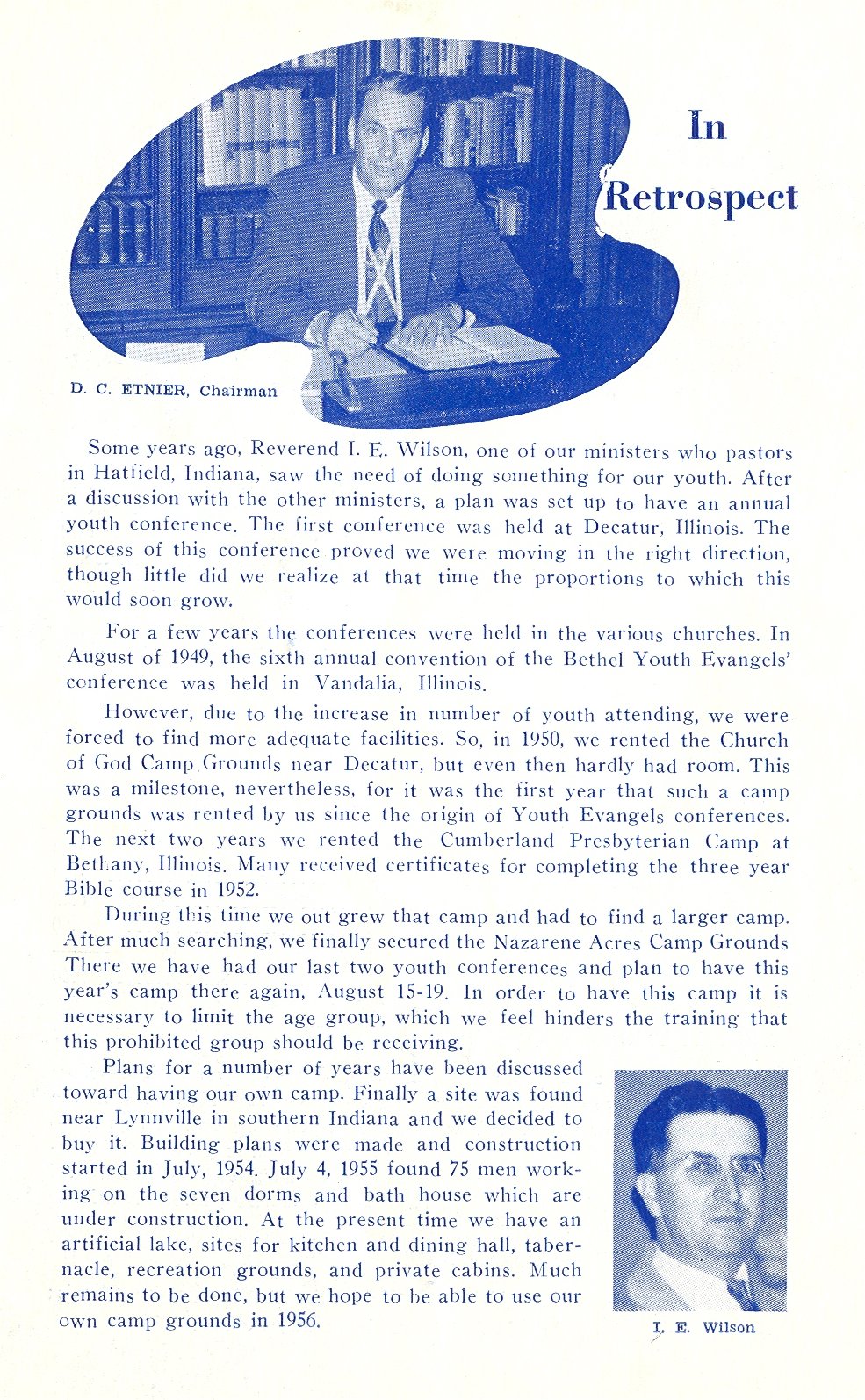
|
“Some years ago, Reverend I.E. Wilson, one of our ministers who pastors in Hatfield, Indiana, saw the need of doing something for our youth. After a discussion with the other ministers, a plan was set up to have an annual youth conference. The first conference was held at Decatur, Illinois. The success of this conference proved we were moving in the right direction, though little did we realize at that time the proportions to which this would soon grow. For a few years the conferences were held in the various churches. In August of 1949, the sixth annual convention of the Bethel Youth Evangels’ conference was held in Vandalia, Illinois. However, due to the increase in number of youth attending, we were forced to find more adequate facilities. So, in 1950, we rented the Church of God Camp Grounds near Decatur, but even then hardly had room. This was a milestone, nevertheless, for it was the first year that such a camp grounds was rented by us since the origin of Youth Evangels conferences. The next two years we rented the Cumberland Presbyterian Camp at Bethany, Illinois. Many received certificates for completing the three year Bible course in 1952. During this time we out grew that camp and had to find a larger camp. After much searching, we finally secured the Nazarene Acres Camp Grounds. There we have had our last two youth conferences and plan to have this year’s camp there again, August 15-19. In order to have this camp it is necessary to limit the age group, which we feel hinders the training that this prohibited group should be receiving. Plans for a number of years have been discussed toward having our own camp. Finally a site was found near Lynnville in southern Indiana and we decided to buy it. Building plans were made and construction started in July, 1954. July 4, 1955 found 75 men working on the seven dorms and bath house which are under construction. At the present time we have an artificial lake, sites for kitchen and dining hall, tabernacle, recreation grounds, and private cabins. Much remains to be done, but we hope to be able to use our own camp grounds in 1956.” |
The plans and progress made by these bold ministers was adventurous. Despite the continuous growth, the council continued to hold its very successful Youth Camp programs at Nazarene Acres through 1956 and held its inaugural Bethel Youth Camp in the summer of 1959, after completion of the Dining Hall. That year, a “time capsule” with precious items inside was cemented in place in the corner of the dining hall, not to be opened until fifty years later, after years and years of successful Youth Camp programs in the summer of 2009. We will look at the Youth Camp program in much greater detail in the chapter dedicated to it. But it goes without saying that the most successful program started by the Council/association in this decade was Bethel Youth Camp. It still reaches teens and inspires them to live their lives for Jesus some sixty years later.
 Brothers Glen Dyhouse, I.E. Wilson and R.R. Schwambach installing cornerstone at Youth Camp 1959 |
|
Several times during the decade, the Council decided it would be a good idea to publish regular issues of “newsletters” to be the “official organ of the Ministerial Council of the Bethel Assemblies.” Initially, as early as 1937, the Council published what they called the “Evangelistic Ministerial Council Messenger.” By 1943, they were publishing the “Evangelistic Beacon.” Now, in 1953, Rev Don Matthews became the editor for “Words With Power.” Before the end of the decade, in 1955, Brother Max Campbell, Harvey Davids and Paul Schwambach would all be contributing to “Publication of Power.” The Bethel brethren were always striving to use every productive avenue of media available to “get their words out.” They never shied away from trying new methods to communicate either. Later in the decade, they established their own publishing arm with leadership from Rev R.R. Schwambach, through the Bethel Publishing House. This drive to use modern media to reach out with the gospel never ceased...in the 60s and 70s, the association even experimented with several different forms of audio recording, video recording and when it came along in the 80s and 90s, pushed into computer technology and movie productions. Television broadcasts were popular, especially by the churches in Evansville and Decatur. The Bethel brethren were always progressive in trying new, innovative ways of reaching out and spreading the Word of the Gospel around the world. In the middle of the decade, 1955, the council accepted a “Five Point Development Program” from Rev R.R. Schwambach that included 1. The Publication of Power newsletter, 2. Youth Camp Development, 3. Bethel Publishing House, 4. Sunday School Department and 5. Bethel Bible Schools. Brother Richard’s brother, Paul Schwambach, fresh from graduation at Central Bible Institute in Springfield, Missouri was quickly ordained and very instrumental in the Youth Camp and other Bethel programs. Even a Sunday School Convention was added to the calendar that year for the member churches. New names and pastorates were being added to the original ones yearly. Now, Brother Eugene Holder and Brother Jack Morrow from Open Bible Tabernacle in Marietta, Georgia were added to the leaders of the association. The Hatfield Bethel Church was started by Brother Wilson and added to the participating churches in the 1950s, as was Vandalia, IL, Vincennes, IN and later Indianapolis. Brother Wendell Nance, a fiery preacher with charismatic preaching talents joined in 1957. Brother Varnell and then, Brother Max Campbell moved to California and represented the council there. The Council was starting to look like a national association rather than just a regional one. The only thing that remained at the end of the decade was one more chance to change the name. This time, at the 1958 Thanksgiving Conference held in Evansville, the motion was made, seconded and approved by majority vote to change the name to Bethel Baptist Assembly. This name change would be short-lived however. As several would later relate, Brother Varnell inspired the name change with the hopes of becoming attractive to brethren from the Baptist denomination in years to come. Unfortunately, the Pentecostal doctrines that Bethel held dear would never appeal to Baptists, and not too many years later, the council would adapt yet another name. In the 60s, the name Bethel Ministerial Association would be adopted, and stay with the association of ministers that so many had enjoyed at one time or another calling “home.” |
|
Click here to return to home |
DaveM3333@aol.com
page created by daveweb1.com
|
